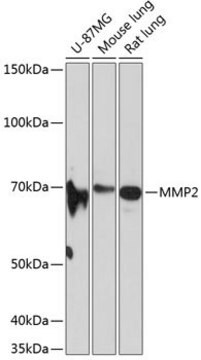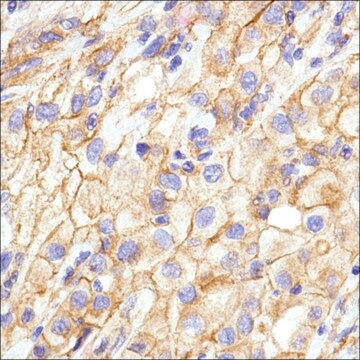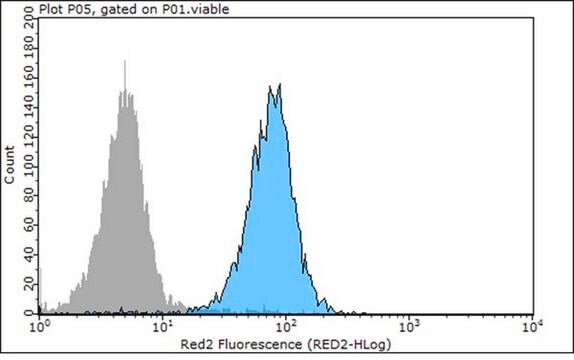推薦產品
生物源
mouse
品質等級
抗體表格
culture supernatant
抗體產品種類
primary antibodies
無性繁殖
13A9, monoclonal
物種活性
human
包裝
antibody small pack of 25 μL
製造商/商標名
Upstate®
技術
immunocytochemistry: suitable
immunohistochemistry: suitable
immunoprecipitation (IP): suitable
western blot: suitable
NCBI登錄號
UniProt登錄號
運輸包裝
ambient
目標翻譯後修改
unmodified
基因資訊
human ... CDH2(1000)
一般說明
Cadherin-2 (UniProt P19022; also known as CD325, CDw325, N-cadherin, Neural cadherin) is encoded by the CDH2 (also known as CDHN, NCAD) gene (Gene ID 1000) in human. Cadherins constitute a family of calcium-dependent cell-cell adhesion proteins that play important roles in the embryonic development and maintenance of normal tissue architecture. Cadherins are composed of an extracellular domain (a.a. 160-724 of human N-cadherin) with five homologous repeats that mediates adhesion, a single pass transmembrane domain (a.a. 725-745 of human N-cadherin), and a conserved cytoplasmic domain (a.a. 746-906 of human N-cadherin) that interacts with catenins to link cadherins to the actin cytoskeleton. In addition, a known Src substrate p120ctn also modulate the strength of cadherin-dependent adhesion by interacting with cadherins at their intracellular juxtamembrane domain. Cadherins are synthesized as precursor proteins that must be proteolytically cleaved to generate functional, mature proteins. Newly synthesized proN-cadherin (a.a. 1-906) is phosphorylated and proteolytically processed prior to transport to the plasma membrane. In addition, Plakoglobin (gamma-catenin) and beta-catenin associate only with phosphorylated proN-cadherin, whereas p120ctn can associate with both phosphorylated and non-phosphorylated proN-cadherin. The N-terminal signal and propeptide (a.a. 1-25 and 26-159 of of human N-cadherin) region is proteolytically removed and a core N-cadherin-catenin complex is assembled in the endoplasmic reticulum or Golgi compartment prior to localization at the plasma membrane where linkage to the actin cytoskeleton can be established.
特異性
Clone 13A9 recognizes N-cadherin, but not P-, E-, or M-cadherin (Knudsen, K.A., et al. (1995). J. Cell Biol. 130(1):67-77).
免疫原
Bacterially expressed human N-cadherin cytoplasmic domain MBP fusion protein (Knudsen, K.A., et al. (1995). J. Cell Biol. 130(1):67-77).
Epitope: Cytoplasmic domain.
應用
Detect N-cadherin using this Anti-N-Cadherin Antibody, clone 13A9 validated for use in Immunocytochemistry, Immunohistochemistry, Immunoprecipitation, and Western Blotting.
Immunohistochemistry Analysis: A representative lot immunostained the extracellular matrix of the stable plaques and in the fibrous cap region rich in vascular smooth muscle cells (VSMCs) using patients-derived paraffin-embedded internal carotid artery tissue sections (Musumeci, G., et al. (2014). Histol. Histopathol. 29(6):707-719).
Immunohistochemistry Analysis: A representative lot detected strong N-cadherin immunoreactivity in paraffin-embedded rectal cancer (RC) tissues with positive regional lymph node metastasis (RLNM) status, while only weak N-cadherin immunoreactivity was detected in RC with negative RLNM, and no N-cadherin staining was seen in normal colorectal epithelium (Fan, X.J., et al. (2012). Br. J. Cancer. 106(11):1735-1741).
Immunohistochemistry Analysis: A representative lot detected N-cadherin immunoreactivity in formalin-fixed, paraffin-embedded hepatocellular carcinoma (HCC) tissue sections. A significant inverse correlation was found between RUNX3 and N-cadherin expression levels (Tanaka, S., et al. (2012). Int. J. Cancer. 131(11):2537-2546).
Western Blotting Analysis: A representative lot detected an upregulated N-cadherin expression in CCL185 carcinoma cells following transient Epstein-Barr virus (EBV) infection. The EMT-like phenotype remained even after viral loss by culture selection pressure withdrawal (Queen, K.J., et al. (2013). Int. J. Cancer. 132(9):2076-2086).
Western Blotting Analysis: A representative lot detected N-cadherin in Hep3B, Huh7, HLF and SK-Hep1 human hepatocellular carcinoma (HCC) cell lysates (Tanaka, S., et al. (2012). Int. J. Cancer. 131(11):2537-2546).
Western Blotting Analysis: A representative lot detected both the unprocessed (pro-) and processed (mature) forms of N-cadherin in HeLa cell lysate (Wahl, J.K. 3rd., et al. (2003). J. Biol. Chem. 278(19):17269-17276).
Western Blotting Analysis: A representative lot detected N-cadherin in WI-38 human fibroblast lysate, but not in JAr human placental choriocarcinoma cell lysate (Knudsen, K.A., et al. (1995). J. Cell Biol. 130(1):67-77).
Immunocytochemistry Analysis: A representative lot detected N-cadherin immunoreactivity localized primarily at the cell-cell borders by fluorescent immunocytochemistry staining of 1% paraformaldehyde-fixed, methanol-permeabilized HeLa cells (Wahl, J.K. 3rd., et al. (2003). J. Biol. Chem. 278(19):17269-17276).
Immunocytochemistry Analysis: A representative lot detected N-cadherin immunoreactivity colocalized with those of alpha- and beta-catenin by dual fluorescent immunocytochemistry staining of fixed WI-38 human fibroblasts (Knudsen, K.A., et al. (1995). J. Cell Biol. 130(1):67-77).
Immunoprecipitation Analysis: Representative lots co-immunoprecipitated alpha-catenin, beta-catenin, and plakoglobin with N-cadherin from WI-38 human fibroblast and HeLa cell lysates (Wahl, J.K. 3rd., et al. (2003). J. Biol. Chem. 278(19):17269-17276; Knudsen, K.A., et al. (1995). J. Cell Biol. 130(1):67-77).
Immunohistochemistry Analysis: A representative lot detected strong N-cadherin immunoreactivity in paraffin-embedded rectal cancer (RC) tissues with positive regional lymph node metastasis (RLNM) status, while only weak N-cadherin immunoreactivity was detected in RC with negative RLNM, and no N-cadherin staining was seen in normal colorectal epithelium (Fan, X.J., et al. (2012). Br. J. Cancer. 106(11):1735-1741).
Immunohistochemistry Analysis: A representative lot detected N-cadherin immunoreactivity in formalin-fixed, paraffin-embedded hepatocellular carcinoma (HCC) tissue sections. A significant inverse correlation was found between RUNX3 and N-cadherin expression levels (Tanaka, S., et al. (2012). Int. J. Cancer. 131(11):2537-2546).
Western Blotting Analysis: A representative lot detected an upregulated N-cadherin expression in CCL185 carcinoma cells following transient Epstein-Barr virus (EBV) infection. The EMT-like phenotype remained even after viral loss by culture selection pressure withdrawal (Queen, K.J., et al. (2013). Int. J. Cancer. 132(9):2076-2086).
Western Blotting Analysis: A representative lot detected N-cadherin in Hep3B, Huh7, HLF and SK-Hep1 human hepatocellular carcinoma (HCC) cell lysates (Tanaka, S., et al. (2012). Int. J. Cancer. 131(11):2537-2546).
Western Blotting Analysis: A representative lot detected both the unprocessed (pro-) and processed (mature) forms of N-cadherin in HeLa cell lysate (Wahl, J.K. 3rd., et al. (2003). J. Biol. Chem. 278(19):17269-17276).
Western Blotting Analysis: A representative lot detected N-cadherin in WI-38 human fibroblast lysate, but not in JAr human placental choriocarcinoma cell lysate (Knudsen, K.A., et al. (1995). J. Cell Biol. 130(1):67-77).
Immunocytochemistry Analysis: A representative lot detected N-cadherin immunoreactivity localized primarily at the cell-cell borders by fluorescent immunocytochemistry staining of 1% paraformaldehyde-fixed, methanol-permeabilized HeLa cells (Wahl, J.K. 3rd., et al. (2003). J. Biol. Chem. 278(19):17269-17276).
Immunocytochemistry Analysis: A representative lot detected N-cadherin immunoreactivity colocalized with those of alpha- and beta-catenin by dual fluorescent immunocytochemistry staining of fixed WI-38 human fibroblasts (Knudsen, K.A., et al. (1995). J. Cell Biol. 130(1):67-77).
Immunoprecipitation Analysis: Representative lots co-immunoprecipitated alpha-catenin, beta-catenin, and plakoglobin with N-cadherin from WI-38 human fibroblast and HeLa cell lysates (Wahl, J.K. 3rd., et al. (2003). J. Biol. Chem. 278(19):17269-17276; Knudsen, K.A., et al. (1995). J. Cell Biol. 130(1):67-77).
Research Category
Cell Structure
Cell Structure
Research Sub Category
Adhesion (CAMs)
Adhesion (CAMs)
品質
Evaluated by Western Blotting in HeLa cell lysate.
Western Blotting Analysis: A 1:1000-5000 dilution of this hybridoma culture supernatant detected N-cadherin in HeLa cell lysate.
Western Blotting Analysis: A 1:1000-5000 dilution of this hybridoma culture supernatant detected N-cadherin in HeLa cell lysate.
標靶描述
~140 kDa observed. Target band size appears larger than the calculated molecular weights of 82.03 kDa (mature) and 99.81/97.04 kDa (isoform 1/2 pro-form) due to posttranslational glycosylation and phosphorylation.
聯結
Replaces: 04-1126
外觀
Unpurified
Mouse monoclonal immunoglobulin hybridoma culture supernatant containing 0.05% sodium azide before the addition of glycerol to 30%.
儲存和穩定性
Maintain for 2 years at -20°C from date of shipment. Aliquot to avoid repeated freezing and thawing. For maximum recovery of product, centrifuge the original vial after thawing and prior to removing the cap.
分析報告
Control
HeLa cell lysate
HeLa cell lysate
法律資訊
UPSTATE is a registered trademark of Merck KGaA, Darmstadt, Germany
免責聲明
Unless otherwise stated in our catalog or other company documentation accompanying the product(s), our products are intended for research use only and are not to be used for any other purpose, which includes but is not limited to, unauthorized commercial uses, in vitro diagnostic uses, ex vivo or in vivo therapeutic uses or any type of consumption or application to humans or animals.
Not finding the right product?
Try our 產品選擇工具.
分析證明 (COA)
輸入產品批次/批號來搜索 分析證明 (COA)。在產品’s標籤上找到批次和批號,寫有 ‘Lot’或‘Batch’.。
Anwen Liu et al.
Journal of biochemical and molecular toxicology, 38(4), e23705-e23705 (2024-04-11)
We explored the role and mechanism of circular RNAcircNRD1 in gastric cancer (GC) progression, aiming to identify new bio-markers for the treatment and prognosis of GC patients. The RNA expression was examined by reverse transcription-quantitative polymerase chain reaction. Cell proliferation
X-J Fan et al.
British journal of cancer, 106(11), 1735-1741 (2012-04-28)
Current imaging modalities are inadequate in preoperatively predicting regional lymph node metastasis (RLNM) status in rectal cancer (RC). Here, we designed support vector machine (SVM) model to address this issue by integrating epithelial-mesenchymal-transition (EMT)-related biomarkers along with clinicopathological variables. Using
Abdul Soofi et al.
Developmental biology, 365(1), 241-250 (2012-03-14)
The Pax2 gene encodes a DNA binding protein with multiple functions in the developing intermediate mesoderm and urogenital tract. Loss of Pax2 in mice results in the complete absence of kidneys, ureters, and sex specific epithelial structures derived from the
Shigetomi Tanaka et al.
International journal of cancer, 131(11), 2537-2546 (2012-04-11)
Loss or decreased expression of runt-related transcription factor 3 (RUNX3), a tumor suppressor gene involved in gastric and other cancers, has been frequently observed in hepatocellular carcinoma (HCC). The objective of this study was to identify the regulatory mechanism of
Lei Wang et al.
Oncology reports, 42(5), 2169-2178 (2019-08-23)
Esophageal adenocarcinoma (EAC) is an aggressive and challenging disease to treat, with an overall five‑year survival rate of <20%. Early malignant cell dissemination contributes to this poor prognosis. Epithelial‑mesenchymal transition (EMT) induces the invasion and metastasis of carcinoma cells. Empty
文章
Human iPSC neural differentiation media and protocols used to generate neural stem cells, neurons and glial cell types.
用於產生神經幹細胞、神經元和膠質細胞類型的人類 iPSC 神經分化培養基和方案。
我們的科學家團隊在所有研究領域都有豐富的經驗,包括生命科學、材料科學、化學合成、色譜、分析等.
聯絡技術服務








